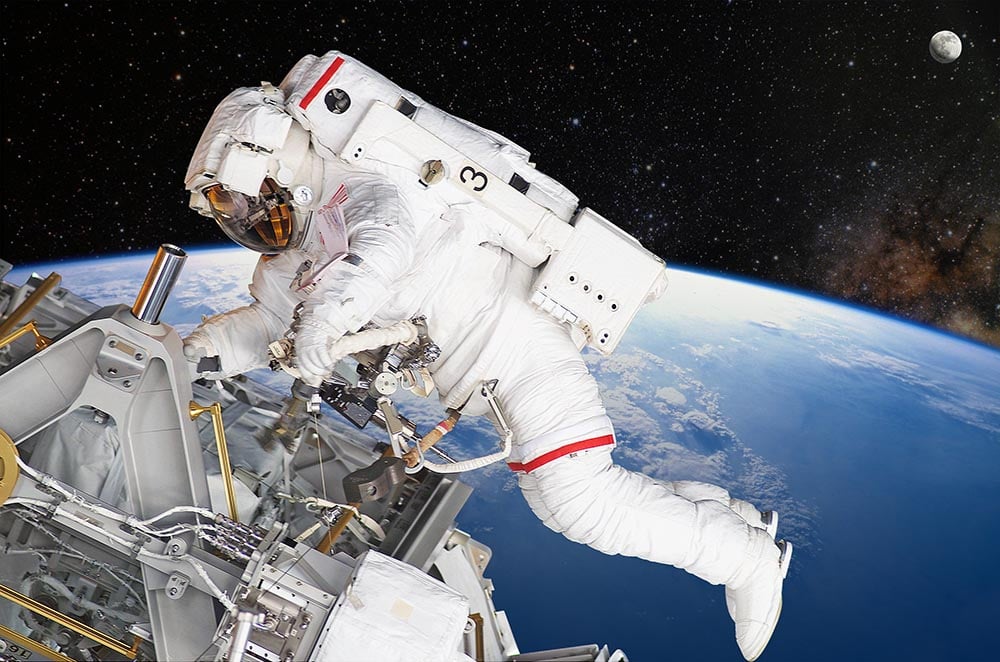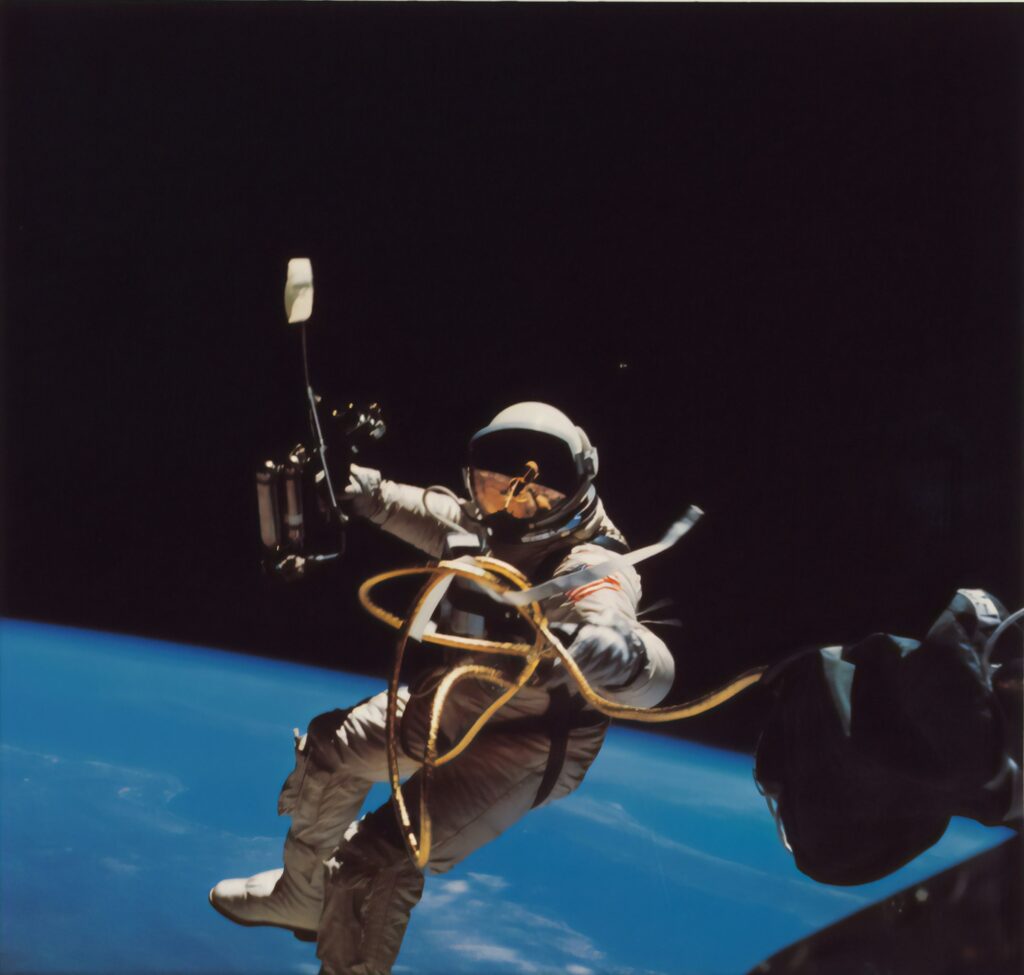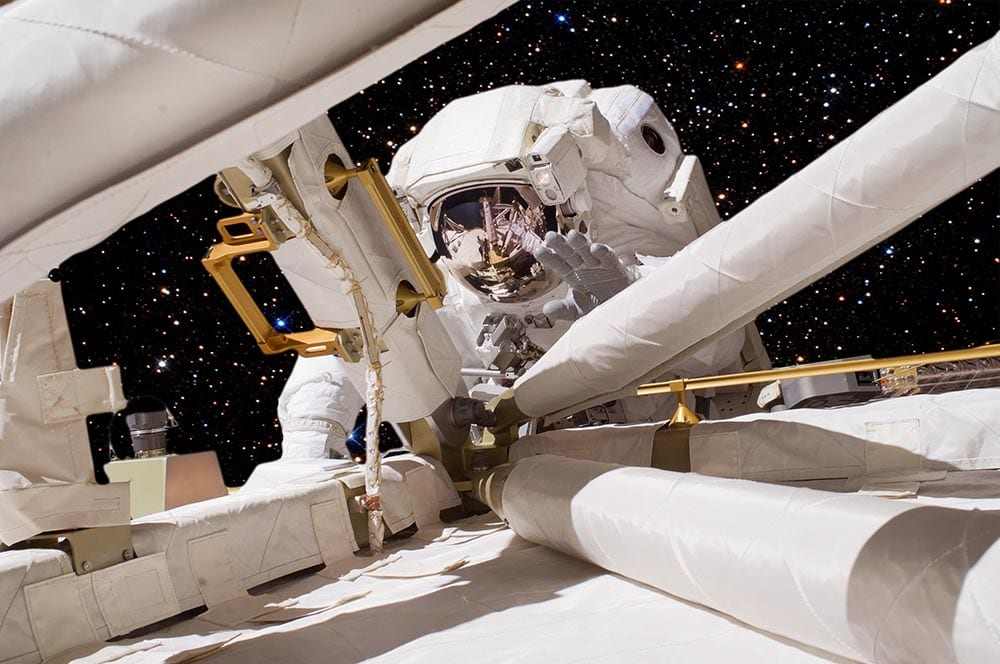Can You Weld in Space? The Shocking Answer!
Last Updated on

Welding in space is possible using a process known as cold welding. On Earth, you need heat to weld two metals together. This entails heating the metals until you reach the melting point. But in space, you don’t have to use heat to fuse two metals.
Cold welding is the best process to use when fusing metal in such a volatile environment. It dates back to the 1940s and is considered a general materials phenomenon. In a vacuum such as space, two similar materials like metal fuse together through contact welding.
In this article, you can learn all about welding in space. Keep reading for a deeper insight.
Who Was the First Astronaut to Weld in Space?
The first people to weld in space were Russian cosmonauts named Georgi Shonin and Valeri Kubasov. This happened back in 1969 at a time when space exploration was heating up. The goal of this first trial was to test the dangers of welding in outer space.
This Russian team did a series of experiments that involved three welding techniques. They wanted to see which among them was effective in creating lasting bonds and also safe to use in the new environment. The three welding techniques were:
- Arc welding using a consumable electrode
- Electron beam welding
- Low-pressure compressed arc welding
Many changes have since taken place in space technology, allowing better cold welding to happen in outer space. There are more advanced practices when it comes to welding inside and outside the space crafts. Plus, astronauts have a better understanding of materials that work well with cold welding.

Why is Welding in Space Challenging?
Welding is a process of joining two materials, usually metals or thermoplastics, by using high heat to melt the parts together and cause them to fuse. Welding in space presents some unique challenges that must be considered to be successful.
One of the biggest challenges is the fact that there is no atmosphere in space. This means that there is no air to help support the welding process. To weld in space, special equipment must be used that can provide an atmosphere for the weld to take place.
Another challenge is the lack of gravity. This can make it difficult to position the materials being welded in the correct position. Special fixtures and tools may be needed to help keep the materials in place.
- Related read: How Much Do Aerospace Welders Make? Salary Statistics
The third challenge is the extreme temperatures that can be present in space. This can cause the materials being welded to expand or contract, making the welding process more difficult.
Despite these challenges, welding in space is possible and has been successfully used on many occasions. With the right equipment and planning, welding in space can be a successful and reliable way to join materials.
Space Cold Welding
Welding in a vacuum requires a different thought process than normal heat welding. In space, astronauts have to use different tactics to fuse metal parts together when conducting repairs. Instead of heat, they use contact or cold welding.
There’s lots of pressure in outer space that fuses two metal parts together. But this can only happen if the materials are clean and similar. It’s not possible to fuse metal and wood in space, so other ways to attach such parts is necessary.
Still, cold welding remains one of the most efficient ways to weld in space. The two metal parts that you need to attach always remain solid. This is different from the standard heat welding, where a molten state is necessary to fuse two metal pieces.
Astronauts have a bit of a process before they can employ cold welding in space. The first step is removing any oxide layers on the two metal parts. It’s not uncommon to find an oxide protective layer on metal, preventing bonding.
The best way to remove the oxide layer is by brushing, degreasing, or using chemical means. After removing the metal oxide, the next step entails bonding the two metal parts under high pressure. This is what creates metallurgical bonds.
Contact welding requires that the two metal parts be in the best state. This means they shouldn’t have undergone any hardening. As a result, most astronauts prefer working with soft metals that are more ductile and create lasting bonds.
The 5 Step Process of Cold Welding
- The first step is to clean the surfaces of the materials that are going to be welded. This is important to ensure a good connection between the two pieces.
- Next, the materials are positioned so that they are flush with each other. Once again, this is important for making a good connection.
- A cold welding machine is then used to create an electrical connection between the two pieces. This connection will allow the current to flow between the two pieces and create the weld.
- The cold welding machine will then supply a current to the two pieces. This current will cause the two pieces to heat up and eventually weld together.
- Once the weld is complete, the cold welding machine is removed, and the two pieces are allowed to cool.

Advantages of Cold Welding
Cold Welding Doesn’t Create a HAZ (Heat Affected Zone)
Heat welding requires melting two metal parts to fuse them together. One disadvantage of heat welding is creating a Heat Affected Zone (HAZ). This happens due to exposure to high temperatures. However, cold welding won’t cause this and results in stronger fusion.
Strong Joints
Cold welding creates strong joints that last in a vacuum, like outer space. The welds are also clean and won’t result in weak intermetallic bonds.
Better Joining of Dissimilar Metals
Some metals, such as copper and aluminum, benefit from cold welding, which allows joining dissimilar metals. It’s also a great way of joining metals such as aluminum 2xxx and 7xxx series. This isn’t possible to do using other metal joining methods.
Disadvantages of Cold Welding
Requires Proper Metal Preparation
In outer space, astronauts can’t simply do cold welding. They first have to clean the metals to get rid of any dirt and oxides. The whole process takes time in a hazardous environment, especially if the parts being joined are big.
Only Specific Materials Can Undergo Cold Welding
Welding in space is a challenging technique since you can’t bond all types of metals. Only ductile metals that haven’t undergone hardening are ideal to fuse together in a vacuum environment.
Only Flat Regular Surfaces Can Do
Cold welding is specific when it comes to the types of welds that are possible to achieve. It’s not possible to weld any irregular surfaces. This technique only applies to flat regular surfaces that join without any difficulties.

Can Metal Weld Itself in Space?
At the moment, there are many metallic structures floating in space. In theory, it’s possible for parts of these metallic structures to weld in space.
However, the chances of this happening are slim to none because of extenuating circumstances. Remember, the only way cold welding can happen in a vacuum is when both fusing surfaces are clean. This means the metal in outer space has to be clean and free of oxides for cold welding to take place.
Metal that’s taken into space has oxide layers. All the satellites and other crafts floating in outer space have a higher chance of colliding than fusing. Since there’s no one there to clean off the oxide layers, metal can’t weld itself in space.
Is It Possible to Prevent Unwanted Cold Welding in Space?
While accidental cold welding isn’t impossible in space, the right environment must be present. Still, a chance of unwanted metal fusion can lead to disastrous results.
So, it’s better to find ways to prevent unwanted cold welding of metal in space. Below are a few ways astronauts can prevent this from taking place.
1. Surface Coating
Cold welding can happen in space if metal surfaces are void of oxide, dirt, and other coatings. The best way to prevent metal fusion is ensuring the metal surfaces have a coating of these substances. That way, astronauts can clean the surfaces if there’s ever a need for specific cold welding.
2. Environmental Exposure Reduction
Some bare metals stand a high chance of cold welding even when this is not necessary. An example are thermally insulated parts that endure thermal cycling exposure, damage from radiation and atomic oxygen. These end up degrading the protective coating that guards against unwanted cold welding in space.
3. Secure Simple Structures
On a spacecraft, there are fasteners, locks, and latches. It’s important to secure them as a way to prevent contamination and wear. This happens because of the presence of abrasive particles that find their way in between these structures.
4. Fewer Moving Parts
Preventing cold welding without prior requirements calls for fewer moving parts. These are surfaces that encounter triboelectric wear and environmental exposure.
Final Thoughts
Welding in space is possible using a process called cold welding. This form of welding differs from the standard heat welding that’s common across the world. Since welding in space happens in a vacuum, there’s no need to use heat to melt the two metal surfaces.
Cold welding fuses two metal parts under high pressure. The process has been around for some time and was first used in 1969 in outer space. At times unwanted cold welding can happen in outer space, so preventing this is essential.
You may also be interested in: Can You Weld Black Pipe? All You Need to Know!
Featured Image Credit: Castleski, Shutterstock
